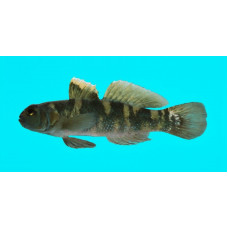Latin name
Bathygobius meggitti
Other name
Meggitt's frillgoby, brownlined goby.
Identification
Characteristics of Meggitt's goby: body shape spindle-shaped; longitudinal row of scales 34-40; predorsal scales 14-19, reaching half the diameter of the eye from the posterior margin; cheek and supraorbital arch without scales; body scales comb-like, changing to cycloidal on the anterior part of the body; head depressed, width greater than depth; body depth 4.1-4.3 inches across.
Features of fish fins
Dorsal spines (total): 7; Dorsal soft rays (total): 9; Anal spines: 1; Anal soft rays: 8.
These fish have seven dorsal spines, eight dorsal soft rays, one anal spine, and eight anal soft rays. The upper five to six pectoral rays are webless. The caudal fin is rounded.
Fish colouring
The male Meggitt's goby is yellowish-gray, densely and intermittently spotted with dark, bluish-white and dull orange spots. Females are dark grayish-brown on the dorsum, paler on the ventral side, with five large yellowish-white spots on the dorsum from the occiput to the caudal peduncle, the outer part of the first dorsal fin of both sexes is yellowish-brown.
Distribution
The Meggitt's goby is native to the Indo-West Pacific.
Habitat
A marine tropical benthic species that prefers brackish water. Occupies rocky intertidal areas and rocky shores.
Size
The maximum length of this species is 6 cm (2.4 inches). Maximum reported age is 3 years.
Behavior
Interesting experiments have been made with this genus. These small fish live in the crevices of underwater rocks, between stones. Before spawning, the male begins to build a nest. When the shelter for the eggs is ready, he calls the female, making low grunting sounds. Using a hydrophone, the scientists tried to transmit the recorded voice of the male into the water. As soon as the device was launched, the fish rushed to it. Many climbed right onto the hydrophone - females went to the male's call, and males swam up to fight.
Food and feeding habits
Meggitt's goby feeds on planktonic crustaceans, polychaetes and algae.
Reproduction
After the eggs are fertilized, the male of these fish guards them from predators and protects them from detritus. He swats the eggs with his fins to provide them with oxygen. The female takes care of the nest. The eggs hatch within a few days. The larvae are born transparent and acquire coloration as they disperse in search of a suitable habitat.
Fishing
This species is not commercially important.
Relationship with a person
Harmless.
| Classification | |
| Phylum | Chordata |
| Class | Actinopterygii |
| Squad | Gobiiformes |
| Family | Gobiidae |
| Genus | Bathygobius |
| Species | B. meggitti |
| Features | |
| Conservation status | Least Concern |
| Habitat | Bottom |
| Life span, years | 3 |
| Maximum body weight, kg | No information |
| Maximum length, cm | 6 |
| Sailing speed, m/s | No information |
| Threat to people | Edible |
| Way of eating | Planktonophage |
Meggitt's goby
Tags: meggitt's goby


